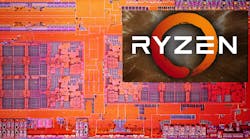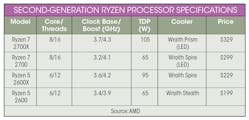Desktop processors comprise a semiconductor category that hasn’t capture much attention in recent years, with the limelight shifting to mobile products, advanced memory ICs, and other “glamorous” high-growth categories. However, AMD’s announcement of its second-generation Ryzen processor targeted at desktop applications reminds us that this segment continues to drive a profitable and competitive market, especially with the strengthening gaming segment.
The new Ryzen chips ratchet up the performance with increased clock speeds and efficiency (see table). Perhaps the biggest enhancement to the offering this year is the free “Wraith” coolers that will ship with every CPU.
Die shot of Ryzen processor.
At the high-end of the new line is the eight-core Ryzen 7 2700X, which increases clock speed to 3.7 GHz with a boost to 4.3 GHz. The most notable part of the new chip is its pricing—the 2700X goes for $329; its 1700X and 1800X predecessors cost $399 and $499, respectively, at launch. This chip is positioned to compete with Intel’s Core i7 product line.
On the lower end is the six-core Ryzen 5 2600, which is priced at $199. It's clocked between 3.4 and 3.9 GHz, and will compete with Intel's Core i5. Given the very different architectural approaches in processor design, a comparison between Intel processors and AMD processors is not simple.
The new Ryzen processors will run on AMD’s new X470 AM4 chipset, and they'll support its StoreMI technology, which can speed up disk performance by linking together solid-state disks (SSDs), traditional hard disks, and RAM. The new CPUs are produced on the company’s 12-nm Zen+ architecture.
The Big Picture for AMD
In its latest financial release, AMD touted its success in growing 2017 revenues by 25% over 2016 with a boost of over $1 billion, reaching total revenue eclipsing $5.3 billion. The “Computing and Graphics” segment accounted for the largest share of AMD’s revenues at 56.8%; “Enterprise, Embedded and Semi-Custom” products accounted for the remaining revenue. Such performance in a highly competitive market that includes Intel is extremely impressive.
While the total semiconductor market grew by 21.2% in 2017, according to World Semiconductor Trade Statistics (WSTS), this double-digit growth was driven by DRAM and data flash-memory ICs. Excluding these two product categories, the total market grew by 9.2%. AMD’s success with its new Ryzen processor family was a key factor in that 2017 uptick.
AMD has identified attractive market segments that will define its future strategy for growth—PCs, data centers, and immersive (primarily gaming). It projects that these markets will drive a total available market (TAM) of $64 billion in 2020. PCs will account for the largest TAM in this segment at $28 billion. While much attention is focused in other areas of the semiconductor industry, AMD will work to continue profitable growth with the Ryzen processor family at the center of its business model.



